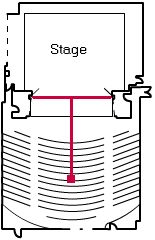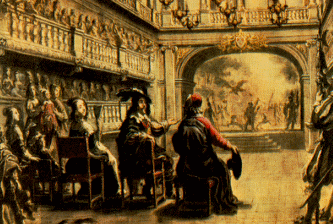
Œil du prince
Encyclopedia



French language
French is a Romance language spoken as a first language in France, the Romandy region in Switzerland, Wallonia and Brussels in Belgium, Monaco, the regions of Quebec and Acadia in Canada, and by various communities elsewhere. Second-language speakers of French are distributed throughout many parts...
expression popularized by Nicola Sabbatini
Nicola Sabbatini
Nicola Sabbatini , also known as Niccolò Sabbatini or Nicola Sabbattini, was an Italian architect of the Baroque....
(1574–1654), an Italian
Italy
Italy , officially the Italian Republic languages]] under the European Charter for Regional or Minority Languages. In each of these, Italy's official name is as follows:;;;;;;;;), is a unitary parliamentary republic in South-Central Europe. To the north it borders France, Switzerland, Austria and...
stage designer and architect
Architect
An architect is a person trained in the planning, design and oversight of the construction of buildings. To practice architecture means to offer or render services in connection with the design and construction of a building, or group of buildings and the space within the site surrounding the...
of the Renaissance
Renaissance
The Renaissance was a cultural movement that spanned roughly the 14th to the 17th century, beginning in Italy in the Late Middle Ages and later spreading to the rest of Europe. The term is also used more loosely to refer to the historical era, but since the changes of the Renaissance were not...
in his famous treatise published in 1638. It is an imaginary point in the audience of a theatre
Theatre
Theatre is a collaborative form of fine art that uses live performers to present the experience of a real or imagined event before a live audience in a specific place. The performers may communicate this experience to the audience through combinations of gesture, speech, song, music or dance...
, located in its central axis, approximately 0.6 m (18 inches) above the stage, and at a distance equal to the stage's width. In most theaters it corresponds more or less to the seventh row of seats. Sabbatini, in a chapter in his book, describes ‘How to Place the Prince’s Seat’, where "all the objects in the scene appear better... than from any other place". It is considered the best place and the most coveted one in the audience, which was reserved for the nobility
Nobility
Nobility is a social class which possesses more acknowledged privileges or eminence than members of most other classes in a society, membership therein typically being hereditary. The privileges associated with nobility may constitute substantial advantages over or relative to non-nobles, or may be...
(thus the reference to the prince
Prince
Prince is a general term for a ruler, monarch or member of a monarch's or former monarch's family, and is a hereditary title in the nobility of some European states. The feminine equivalent is a princess...
). Due to the importance of these spectators, of course, many theater shows had their main movements and happenings designed in order to attract the attention of the prince's eye.
The usefulness of this point is that it permits the stage designer to calculate the perspective
Perspective (graphical)
Perspective in the graphic arts, such as drawing, is an approximate representation, on a flat surface , of an image as it is seen by the eye...
angles of the scenes (decoration) on the stage, as viewed from a central place (the focal point). Beginning in the 17th century, Italian theatrical decoration became very influential in the use of constructions in perspective, which added greater realism to depth perception
Depth perception
Depth perception is the visual ability to perceive the world in three dimensions and the distance of an object. Depth sensation is the ability to move accurately, or to respond consistently, based on the distances of objects in an environment....
by the audience. Thus, it satisfied the baroque
Baroque
The Baroque is a period and the style that used exaggerated motion and clear, easily interpreted detail to produce drama, tension, exuberance, and grandeur in sculpture, painting, literature, dance, and music...
ideal of opening towards the infinity. Sabbatini and others also invented the scene wings which run on grooves in the floor, allowing a quicker change of decorations during the intermissions. These innovations produced what became known as the scènes à l’italienne in theatres in Italy, France
France
The French Republic , The French Republic , The French Republic , (commonly known as France , is a unitary semi-presidential republic in Western Europe with several overseas territories and islands located on other continents and in the Indian, Pacific, and Atlantic oceans. Metropolitan France...
and elsewhere in Europe
Europe
Europe is, by convention, one of the world's seven continents. Comprising the westernmost peninsula of Eurasia, Europe is generally 'divided' from Asia to its east by the watershed divides of the Ural and Caucasus Mountains, the Ural River, the Caspian and Black Seas, and the waterways connecting...
.
In a metaphor
Metaphor
A metaphor is a literary figure of speech that uses an image, story or tangible thing to represent a less tangible thing or some intangible quality or idea; e.g., "Her eyes were glistening jewels." Metaphor may also be used for any rhetorical figures of speech that achieve their effects via...
ical sense, the French language also uses the expression to typify any privileged view of an observer (such as in "he had the eye of the prince when he was covering Iraq's war"), or also in a way of acting so as to please the privileged observer (such as in "he tried to conquer the eye of the prince in his report").
External links
- Glossaire Technique du Théâtre. In French.
- Atelier des Recherches: Le Baroque. In French.

